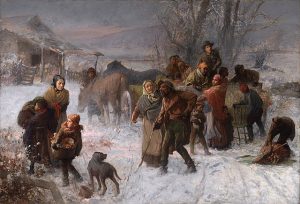Industrial Revolution (1800’s-1940’s)
36 The Underground Railroad
Kassidy Swinyer
Introduction
During a time of renowned technological advances and groundbreaking inventions that propelled American civilizations, the Underground Railroad became one of the most interconnected, well-known yet quiet inventions during this time period. The Underground Railroad was a secret corporation of abolitionists and slaves that fought against the chains of slavery in the 1800s. Although there is no exact timestamp of when the blueprints for this invention originated due to the efforts made to ensure knowledge of the path to freedom remained hidden, the Underground Railroad operated roughly between 1840-1950. At first glance, salvation for enslaved peoples may not seem industrial or technological, but the mechanics of this railroad reveal an ideology that was as revolutionary as a well-oiled machine. In this chapter you will learn about the science and technology that was utilized in the slaves’ grand escape to the Promised Land, and how this extraordinary network of heroes changed the lives of thousands.
The Underground Railroad as a movement in American history is known as the story of slaves escaping their abusive masters, travelling across the country in secret with the help of Quakers who believed in the betterment of all human life and finding their freedom. This understanding of the Underground Railroad is not a false understanding. However, it lacks the means by which the slaves were able to achieve success along their path, and the bigger picture of how this endeavor shaped all of America thereafter.
Science & Technology

Recent studies of old diaries and letters paint the picture of what was left undocumented during the Underground Railroad. Science and technology played huge roles in the slaves’ ability to escape right under the noses of their masters and travel great distances in secret, often to Canada. “Code words would be used in letters to “agents” so that if they were intercepted they could not be caught. Underground Railroad code was also used in songs sung by slaves to communicate among each other without their masters being aware” (Harriet Tubman Historical Society). Technology was not then as we know it now. Communication consisted of letters between “agents”, “conductors”, and “station masters” consisting of the location of the “stations” at which slaves were kept hidden (National Geographic Society, 2023). Their secret language was created by the abolitionists solely for the Underground Railroad while technical jargon and scientific notation were being created for the first steam engine.
Language was not the only tool utilized for the slaves’ salvation. Signals were also invented as a way to light the path such as “chimneys marked with a special row of white or variously colored bricks [that] assured the fugitive that the home beneath was really an underground railroad depot” (Gara, 1967). This evolving technology became a science that had to be studied and learned by the slaves and abolitionists just as a conductor must study the train engine. It was vital to their survival that they stay up to date on new advancements and safer routes for travel. Over the hundred years of operation, the technologies of the Underground Railroad were further developed, optimized, and it is believed that thousands of slaves were able to find freedom.
Impact on society
From the network of science and technology behind the Underground Railroad came salvation. The story of this path to freedom most commonly highlights the abolitionist, “a pure-hearted knight in shining armor” (Gara, 1967), as the heroes that risked everything to save those who were enslaved by their plantation owners in the south. However, it was the slaves that risked their own lives by escaping and travelling across the country that were often their own heroes. “Free Negros contributed much more to such enterprises than they have usually been given credit for, and fugitives who rode the underground railroad line often did so after having already completed the most difficult and dangerous phase of their journey alone and unaided” (Gara, 1967). Lost in the untold records of the secret society were the voices of the slaves that embarked on this dangerous road. Already with limited resources, the enslaved people sang their songs and came together as they changed the trajectory of their lives, and America’s. “The Railroad heightened divisions between the North and South, which set the stage for the Civil War” (National Geographic Society, 2023). Connected across the states, abolitionists and escaped slaves found their voices in the fight against slavery and left an impact on society that changed the federal decree in favor of the human life that was taken from these peoples. The slaves were officially set free by the Emancipation Proclamation in 1950.
conclusion
With a little unconventional science and technology, the abolitionists and enslaved people from the 18 and 1900s found their own freedom and ignited the voices that were kept quiet. This battle for individualism continued as society was all but quick to accept previously believed slaves as people included in their social lives, leading to segregation. The lantern of the Underground Railroad not only shed light on the problems still apparent in the young American government in relation to slavery, but women also began to find their voices in the fight for their equality. The social construct of society may not seem like a scientific or technological advance during the Industrial Revolution at first glance, but The Underground Railroad was a well-oiled machine that changed the ideology of America.
References
Gara, L. (1967). The Liberty Line: The Legend of the Underground Railroad. University Press of Kentucky. https://books.google.com/books?id=gCnV7Yf420oC&lpg=PR7&dq=story%20of%20the%20underground%20railroad&lr&pg=PR7#v=onepage&q=story%20of%20the%20underground%20railroad&f=false
Harriet Tubman Historical Society. (). “Underground Railroad Secret Codes.” Harriet Tubman Historical Society.http://www.harriet-tubman.org/underground-railroad-secret-codes/#:~:text=Code%20words%20would%20be%20used,without%20their%20masters%20being%20aware.&text=Coordinator%2C%20who%20plotted%20courses%20of%20escape%20and%20made%20contacts
National Geographic Society. (2023) “The Underground Railroad.” National Geographic.
https://education.nationalgeographic.org/resource/underground-railroad/
Images
File:The Underground Railroad by Charles T. Webber, 1893.jpg. (2023, February 27). Wikimedia Commons. Retrieved 15:14, November 27, 2023 from https://commons.wikimedia.org/w/index.php?title=Special:CiteThisPage&page=File%3AThe_Underground_Railroad_by_Charles_T._Webber%2C_1893.jpg&id=736369794&wpFormIdentifier=titleform

